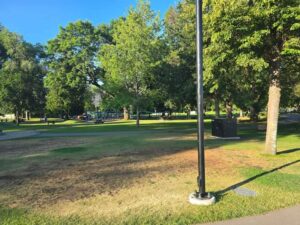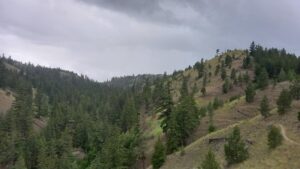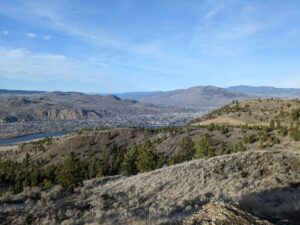Date: 20st July 2024
Location: Kamloops, BC (three specific locations explained below)
Time: 6:30am -11:15 am
Weather: Sunny with a clear sky, wind flowing southwest with a speed of 1.3 m/s
Temperature: 21℃ with 42% humidity
Pressure: 726 mmHg
Area of interest: I had an avid bird-watching hobby that I religiously did for at least 2 years during my pre-teen years. Somehow, as a teenager, I got busier and busier, and my weekly visits to nearby lakes and parks to watch and listen to birds vanished. So, for this field research project, I have decided to observe birds and why I don’t really hear and see them that often anymore. Let me take you through the initial phase of my project—the selection of study locations and my first observations.
Study Locations:
- Riverside Park (Urban): Nestled in the heart of downtown Kamloops, Riverside Park covers approximately 10 hectares. It features landscaped areas with abundant ornamental trees and manicured lawns, flanked by bustling city streets. The park serves as a popular recreational spot, introducing high human activity, which offers a unique setting to study urban impacts on bird life.

Image 1. Riverside Park
Coordinates: 50.6784° N, 120.3369° W
Time of visit: 10:38 am on July 20th, 2024
Observations: The sun was shining high by the time I started canvasing the riverside park. It was bustling with people which was expected as it was a weekend day. The Canadian geese were present everywhere around the park. I saw a bunch of squirrels and dogs on leash. Among the hustle and bustle of the crowd, I could hear some pigeons and crows but was not able to spot them. Also, I was fortunate enough to find two house sparrows sitting on a branch. I canvased the park for about 20 more minutes and found a quiet, isolated spot near a water source which I chose as my future data collection spot.
2. Peterson Creek (Suburban): This suburban greenway extends over 5 hectares, featuring a mix of natural brush and residential gardens. It provides a transitional habitat that supports a variety of bird species, positioned uniquely between urban influences and more natural settings.

Coordinates: 50.6643° N, 120.3298° W
Time of visit: 6:45 am on July 20th, 2024
Observations: The Peterson Creek was the very first location that I decided to canvass and observe. Since I hike often at Peterson Creek, I had already decided on the spot where I would be doing my future data collection. I did a mild hike towards my favourite spot located by the lower trailhead that looks over the city and has a nice bench where I could sit and observe. During the hike, I could hear a bald eagle high up in the sky and some crows nearby. This spot is somewhat I would describe a bird hotspot. I have spotted a mountain bluebird, a house finch, a yellow warbler and a magpie at this spot before. Even though, this time around all I could find was a pigeon family, I definitely have high hopes during my future data collection for this area.
3. Kenna Cartwright Nature Park (Natural): The largest of the three, this park spans nearly 800 hectares of largely undisturbed terrain. It boasts a variety of habitats, including dense forests and open meadows, making it an ideal benchmark for natural bird populations.

Coordinates: 50.6624° N, 120.4030° W
Time of visit: 8:12 am on July 20th, 2024
Observations: My journey to find a suitable bird-watching spot for my future data collection in Kenna Cartwright Park started early in the morning, with the sun just peering through the tall pines, casting long shadows and creating a serene atmosphere. The air was crisp and filled with the rustling sounds of the wind in the trees. High above, the distinct call of a red-tailed hawk echoed, while the chatter of chickadees and the occasional drumming of a woodpecker could be heard closer to the ground where I was hiking. Since I’m not a frequent visitor of Kenna Cartwright Park, I asked a friend to suggest a spot that might be suitable for avian diversity and data collection. I was guided to the tower trail where I spent an hour or more making my initial observations. Today, the area was relatively quiet, save for the playful antics of a squirrel and the distant call of a hawk. Despite the sparse bird sightings on this particular day, the richness of the habitat leaves me optimistic about the potential for significant findings in future observations here.
Interesting Questions
From these initial forays, several questions have emerged that I plan to explore:
- What impact does the presence of human activity have on bird behaviour and species distribution?
- Are there specific bird species that thrive uniquely in urban, suburban, or natural environments?
- How does the species diversity in a highly urbanized area like Riverside Park compares to the more natural settings of Kenna Cartwright Park?
- What are the behavioural adaptations of birds in suburban areas like Peterson Creek, which balances urban and natural elements?
- Can the presence of water bodies within these parks influence bird abundance and diversity, and how does this vary across the urban to natural spectrum?